Experimental and Numerical Investigations on Thermal-Hydraulic Performance of Three-Dimensional Overall Jagged Internal Finned Tubes
Abstract
1. Introduction
2. Experimental Studies
2.1. Characterization of the 3D-OJIFT
2.2. Experimental System
2.3. Data Simplification and Uncertainty Analysis
2.4. Experimental Results
3. Numerical Simulations
3.1. Physical Model
3.2. Governing Equations
3.3. Mesh and Boundary Conditions
3.4. Data Reduction
3.5. Validation
4. Results and Discussion
4.1. Thermo-Hydraulic Characteristics
4.2. The Effect of the Jagged Height
4.3. The Effect of the Jagged Spiral Angle
4.4. Comparison with the Conventional Two-Dimensional Spiral Fin Tubes
4.5. Comparison with Other Reported Studies
4.6. Correlations of the Nusselt Number and Friction Factor
5. Conclusions
- A novel 3D-OJIFT was fabricated using the RPE method. The 3D-OJIF increased the heat transfer area, prevented the development of the velocity and thermal boundary layers, increased the turbulence disturbance, and reduced the temperature gradient, thus enhancing the heat transfer.
- The jagged height of the 3D-OJIFT importantly affected the thermal performance. The Nu and f both increased as the jagged height increased. The Nu of the 3D-OJIFT was 1.59–2.14 times that of the smooth tube.
- The jagged spiral angle of the 3D-OJIFT was very sensitive to the thermal performance. Both Nu and f increased as the jagged spiral angle increased. For better comprehensive heat transfer performance, 3D-OJIFTs with wider jagged spiral angles should be chosen at high Re.
- Compared with conventional IHFTs and other reported studies, the proposed 3D-OJIFT exhibited better comprehensive heat transfer performance. The PEC value of the proposed 3D-OJIFT was 1.03–1.15 times that of the conventional IHFT. Empirical correlations were developed to predict the Nu and f values for 3D-OJIFTs. The discrepancies for Nu and f were within ±11.1% and ±14.3%, respectively.
Author Contributions
Funding
Data Availability Statement
Conflicts of Interest
References
- Khatibi, M.; Kowsari, M.M.; Golparvar, B.; Niazmand, H. Optimum loading of aluminum additive particles in unconsolidated beds of finned flat-tube heat exchangers in an adsorption cooling system. Appl. Therm. Eng. 2021, 196, 117267. [Google Scholar] [CrossRef]
- Tiwari, A.K.; Javed, S.; Oztop, H.F.; Said, Z.; Pandya, N.S. Experimental and numerical investigation on the thermal performance of triple tube heat exchanger equipped with different inserts with WO3/water nanofluid under turbulent condition. Int. J. Therm. Sci. 2021, 164, 106861. [Google Scholar] [CrossRef]
- Ji, W.-T.; Jacobi, A.M.; He, Y.-L.; Tao, W.-Q. Summary and evaluation on single-phase heat transfer enhancement techniques of liquid laminar and turbulent pipe flow. Int. J. Heat Mass Transf. 2015, 88, 735–754. [Google Scholar] [CrossRef]
- Kukulka, D.J.; Smith, R.; Li, W. Comparison of tubeside condensation and evaporation characteristics of smooth and enhanced heat transfer 1EHT tubes. Appl. Therm. Eng. 2015, 89, 1079–1086. [Google Scholar] [CrossRef]
- Li, M.; Khan, T.S.; Al-Hajri, E.; Ayub, Z.H. Single phase heat transfer and pressure drop analysis of a dimpled enhanced tube. Appl. Therm. Eng. 2016, 101, 38–46. [Google Scholar] [CrossRef]
- Kim, J.; Doo, J.; Ha, M.; Yoon, H.; Son, C. Numerical study on characteristics of flow and heat transfer in a cooling passage with protrusion-in-dimple surface. Int. J. Heat Mass Transf. 2012, 55, 7257–7267. [Google Scholar] [CrossRef]
- Afanasyev, V.N.; Chudnovsky, Y.P.; Leontiev, A.I.; Roganov, P.S. Turbulent flow friction and heat transfer characteristics for spherical cavities on a flat plate. Exp. Therm. Fluid Sci. 1993, 7, 1–8. [Google Scholar] [CrossRef]
- Xie, S.; Guo, Z.; Gong, Y.; Dong, C.; Liu, J.; Ren, L. Numerical investigation of thermal-hydraulic performance of a heat exchanger tube with helical dimples. Int. J. Therm. Sci. 2022, 177, 107530. [Google Scholar] [CrossRef]
- Hu, Q.; Qu, X.; Peng, W.; Wang, J. Experimental and numerical investigation of turbulent heat transfer enhancement of an intermediate heat exchanger using corrugated tubes. Int. J. Heat Mass Transf. 2022, 185, 122385. [Google Scholar] [CrossRef]
- Cruz, G.G.; Mendes, M.A.; Pereira, J.M.; Santos, H.; Nikulin, A.; Moita, A.S. Experimental and numerical characterization of single-phase pressure drop and heat transfer enhancement in helical corrugated tubes. Int. J. Heat Mass Transf. 2021, 179, 121632. [Google Scholar] [CrossRef]
- Vicente, P.G.; Garcı, A.; Viedma, A. Mixed convection heat transfer and isothermal pressure drop in corrugated tubes for laminar and transiton flow. Int. Commun. Heat Mass Transf. 2004, 31, 651–662. [Google Scholar] [CrossRef]
- Zdaniuk, G.J.; Chamra, L.M.; Mago, P.J. Experimental determination of heat transfer and friction in helically-finned tubes. Exp. Therm. Fluid Sci. 2008, 32, 761–775. [Google Scholar] [CrossRef]
- Wang, Y.-H.; Zhang, J.-L.; Ma, Z.-X. Experimental determination of single-phase pressure drop and heat transfer in a horizontal internal helically-finned tube. Int. J. Heat Mass Transf. 2017, 104, 240–246. [Google Scholar] [CrossRef]
- Liu, Z.; Yue, Y.; She, L.; Fan, G. Numerical analysis of turbulent flow and heat transfer in internally finned tubes. Front. Energy Res. 2019, 7, 64. [Google Scholar] [CrossRef]
- Celen, A.; Dalkilic, A.S.; Wongwises, S. Experimental analysis of the single phase pressure drop characteristics of smooth and microfin tubes. Int. Commun. Heat Mass Transf. 2013, 46, 58–66. [Google Scholar] [CrossRef]
- Wang, X.; Ho, J.; Leong, K.; Wong, T. Condensation heat transfer and pressure drop characteristics of R-134a in horizontal smooth tubes and enhanced tubes fabricated by selective laser melting. Int. J. Heat Mass Transf. 2018, 126, 949–962. [Google Scholar] [CrossRef]
- Huang, S.; Wan, Z.; Tang, Y. Manufacturing and single-phase thermal performance of an arc-shaped inner finned tube for heat exchanger. Appl. Therm. Eng. 2019, 159, 113817. [Google Scholar] [CrossRef]
- Chen, H.; Wan, Z.; Mo, H.; Huang, S.; Tang, Y. Experimental studies on the compound thermo-hydraulic characteristics in a 3D inner finned tube with porous copper fiber inserts. Int. Commun. Heat Mass Transf. 2019, 100, 51–59. [Google Scholar] [CrossRef]
- Huang, S.; Chen, H.; Zhang, X.; Wan, Z.; Tang, Y. Experimental evaluation of thermal performance in a circular tube with Y-branch insert. Int. Commun. Heat Mass Transf. 2019, 106, 15–21. [Google Scholar] [CrossRef]
- Tan, X.-H.; Zhu, D.-S.; Zhou, G.-Y.; Zeng, L.-D. Experimental and numerical study of convective heat transfer and fluid flow in twisted oval tubes. Int. J. Heat Mass Transf. 2012, 55, 4701–4710. [Google Scholar] [CrossRef]
- Wan, Z.; Tang, Y. Characteristics of uncurled and reversely curled chip during orthogonal cutting. Int. J. Mach. Tools Manuf. 2011, 51, 831–835. [Google Scholar] [CrossRef]
- Webb, R. Performance evaluation criteria for use of enhanced heat transfer surfaces in heat exchanger design. Int. J. Heat Mass Transf. 1981, 24, 715–726. [Google Scholar] [CrossRef]
- Kamboj, K.; Singh, G.; Sharma, R.; Panchal, D.; Hira, J. Heat transfer augmentation in double pipe heat exchanger using mechanical turbulators. Heat Mass Transf. 2017, 53, 553–567. [Google Scholar] [CrossRef]
- Sheikholeslami, M.; Gorji-Bandpy, M.; Ganji, D. Effect of discontinuous helical turbulators on heat transfer characteristics of double pipe water to air heat exchanger. Energy Convers. Manag. 2016, 118, 75–87. [Google Scholar] [CrossRef]
- Tang, X.; Dai, X.; Zhu, D. Experimental and numerical investigation of convective heat transfer and fluid flow in twisted spiral tube. Int. J. Heat Mass Transf. 2015, 90, 523–541. [Google Scholar] [CrossRef]
- Guo, J.; Fan, A.; Zhang, X.; Liu, W. A numerical study on heat transfer and friction factor characteristics of laminar flow in a circular tube fitted with center-cleared twisted tape. Int. J. Therm. Sci. 2011, 50, 1263–1270. [Google Scholar] [CrossRef]
- You, Y.; Fan, A.; Liu, W.; Huang, S. Thermo-hydraulic characteristics of laminar flow in an enhanced tube with conical strip inserts. Int. J. Therm. Sci. 2012, 61, 28–37. [Google Scholar] [CrossRef]
- Launder, B.E.; Spalding, D.B. The numerical computation of turbulent flows. Comput. Methods Appl. Mech. Eng. 1974, 2, 269–289. [Google Scholar] [CrossRef]
- Tu, W.; Wang, Y.; Tang, Y. A numerical study on thermal-hydraulic characteristics of turbulent flow through a circular tube fitted with pipe inserts. Appl. Therm. Eng. 2016, 101, 413–421. [Google Scholar] [CrossRef]
- Huang, S.; Wan, Z.; Wang, Q.; Tang, Y.; Yang, X. Thermo-hydraulic characteristics of laminar flow in a circular tube with porous metal cylinder inserts. Appl. Therm. Eng. 2017, 120, 49–63. [Google Scholar] [CrossRef]
- Li, X.W.; Meng, J.A.; Li, Z.X. Experimental study of single-phase pressure drop and heat transfer in a micro-fin tube. Experi-Ment. Therm. Fluid Sci. 2008, 32, 641–648. [Google Scholar] [CrossRef]
- Dizaji, H.S.; Jafarmadar, S.; Mobadersani, F. Experimental studies on heat transfer and pressure drop characteristics for new arrangements of corrugated tubes in a double pipe heat exchanger. Int. J. Therm. Sci. 2015, 96, 211–220. [Google Scholar] [CrossRef]
- Vicente, P.G.; Garcí, A.A.; Viedma, A. Heat transfer and pressure drop for low Reynolds turbulent flow in helically dimpled tubes. Int. J. Heat Mass Transf. 2002, 45, 543–553. [Google Scholar] [CrossRef]
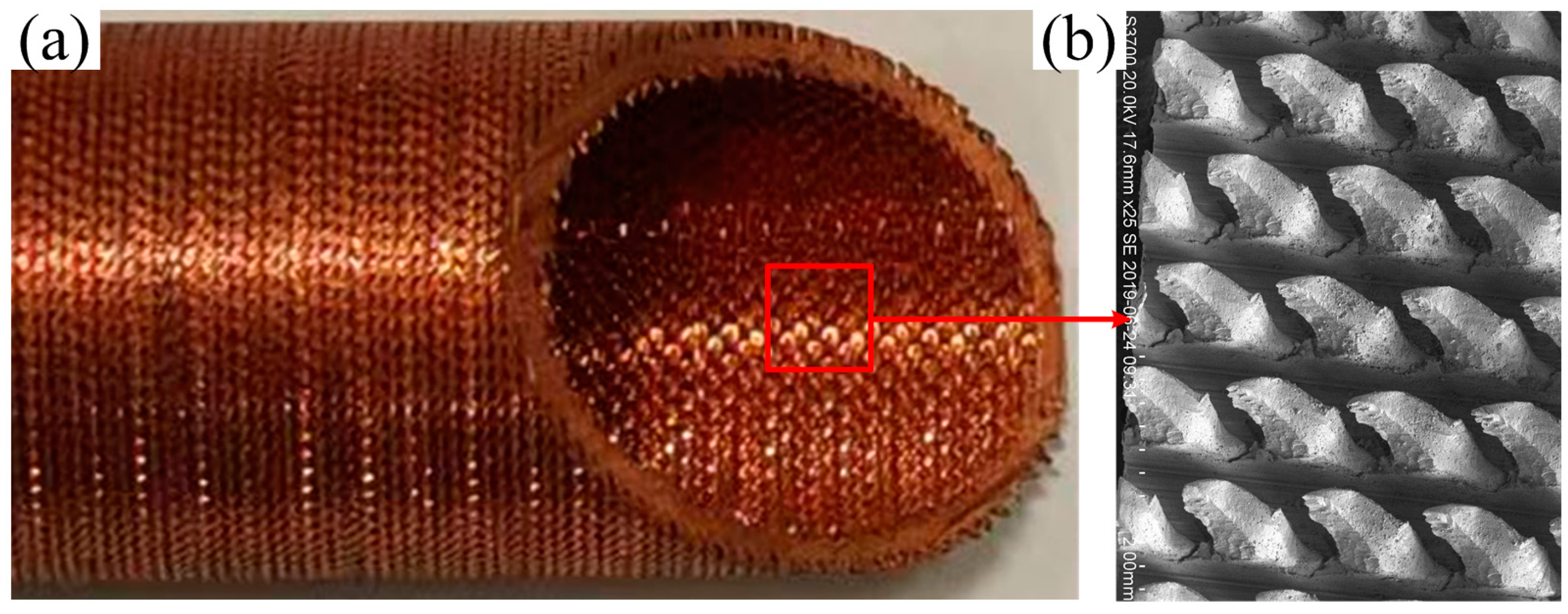
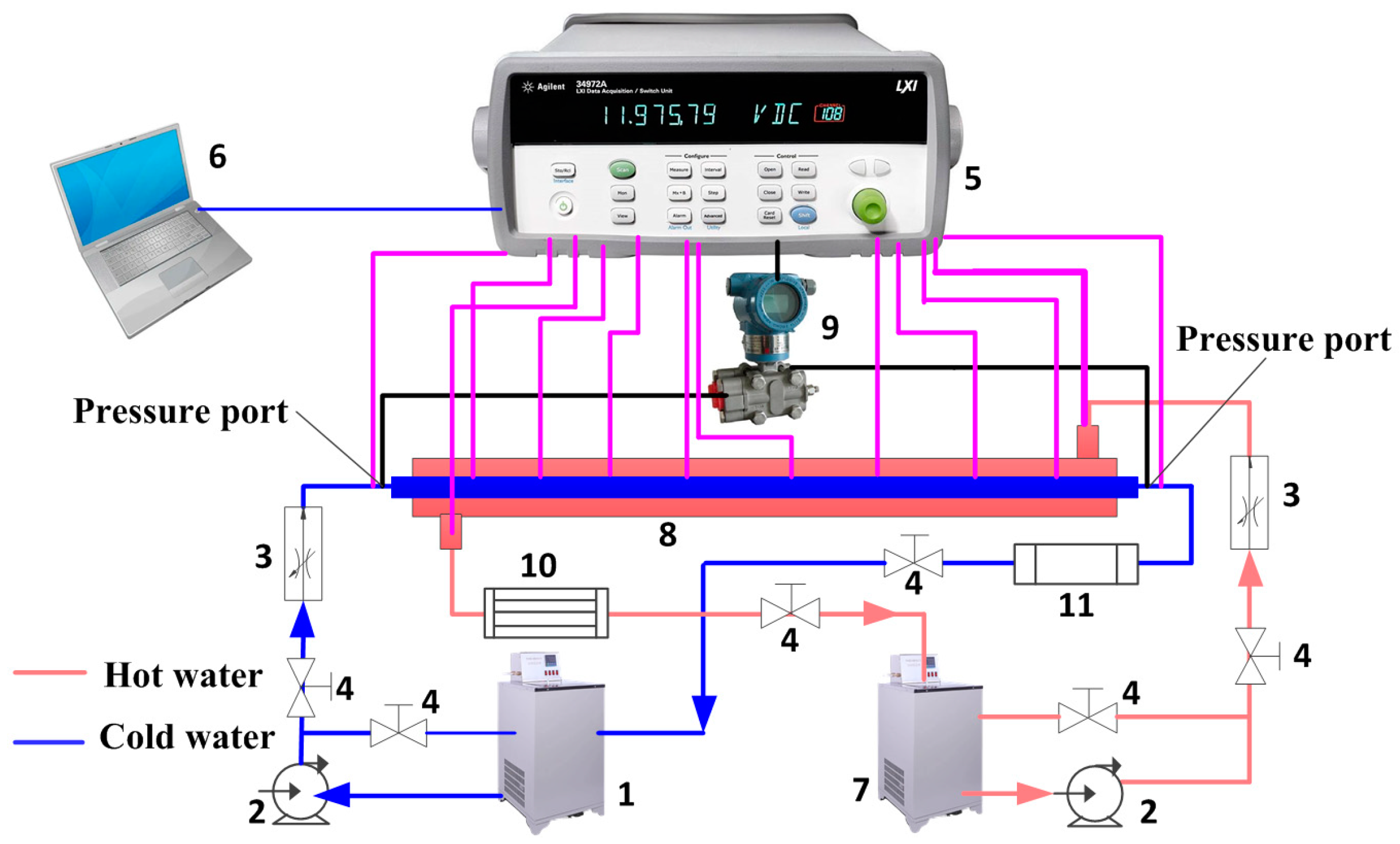
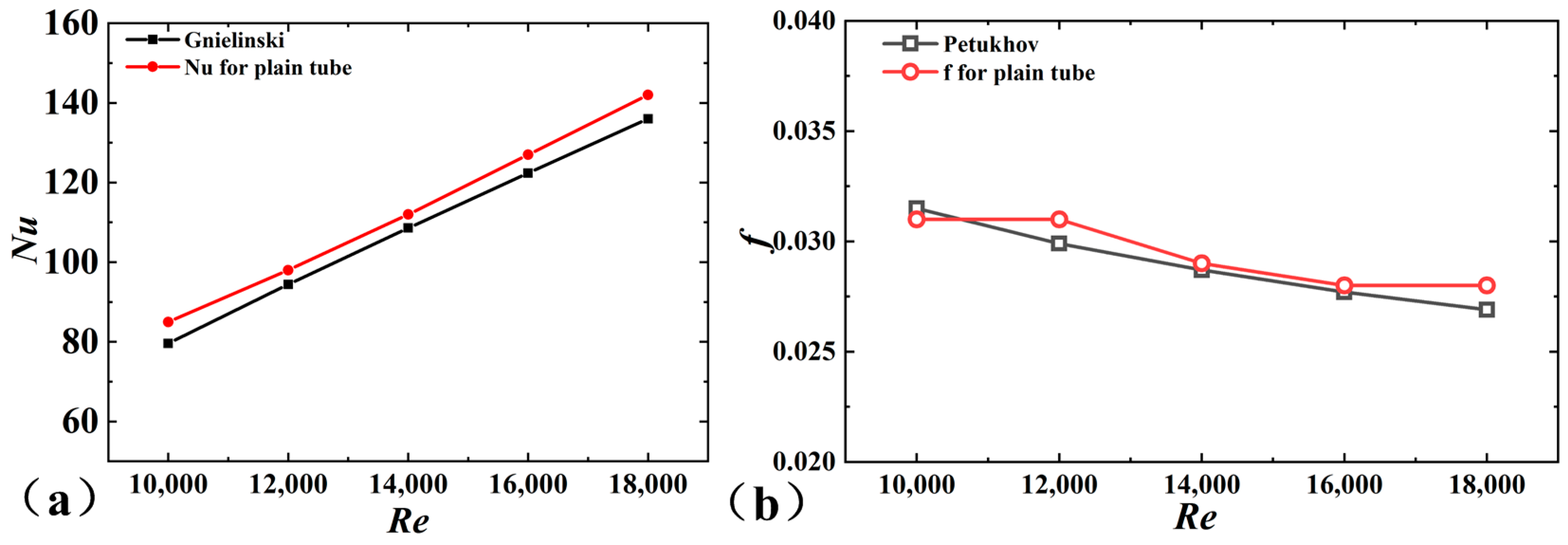
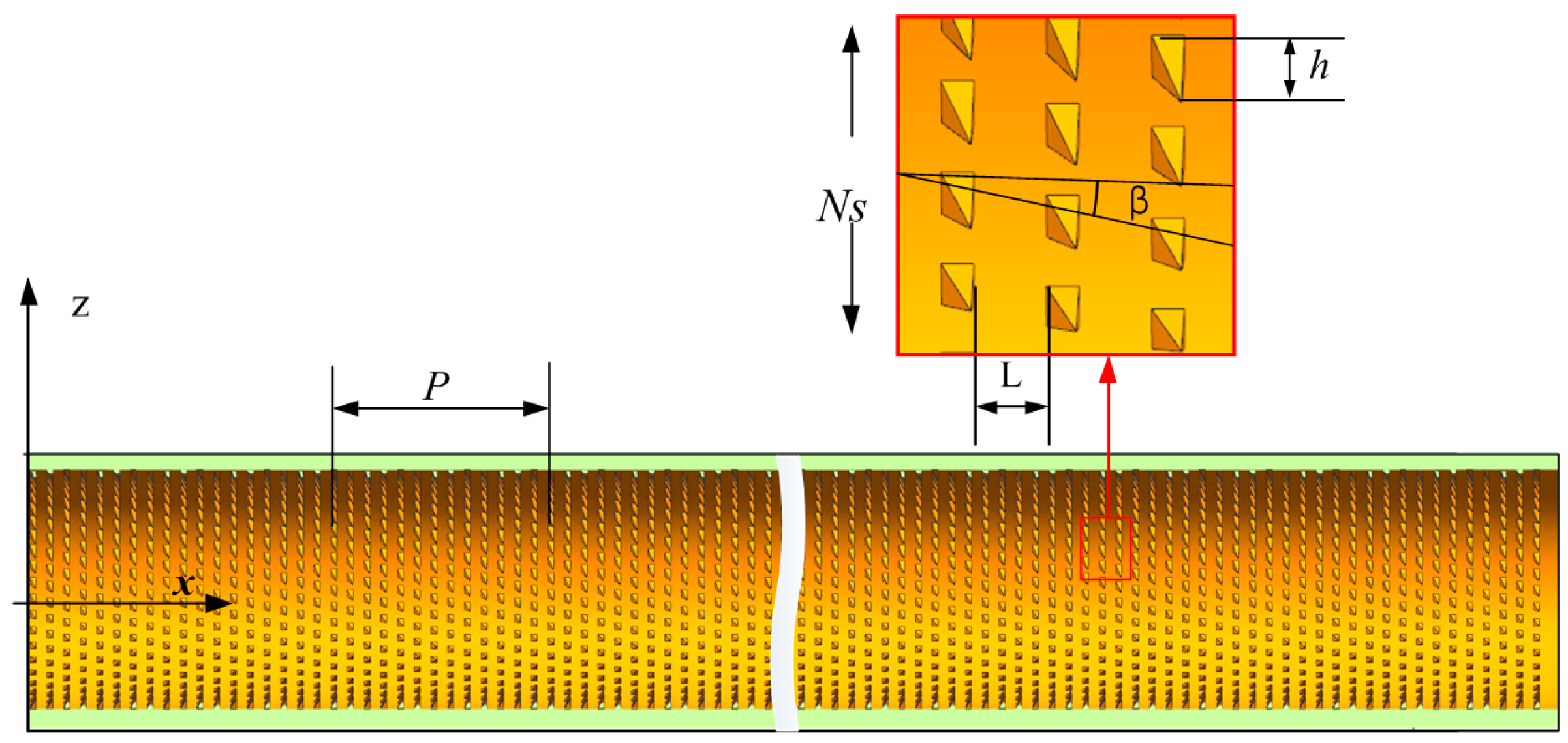

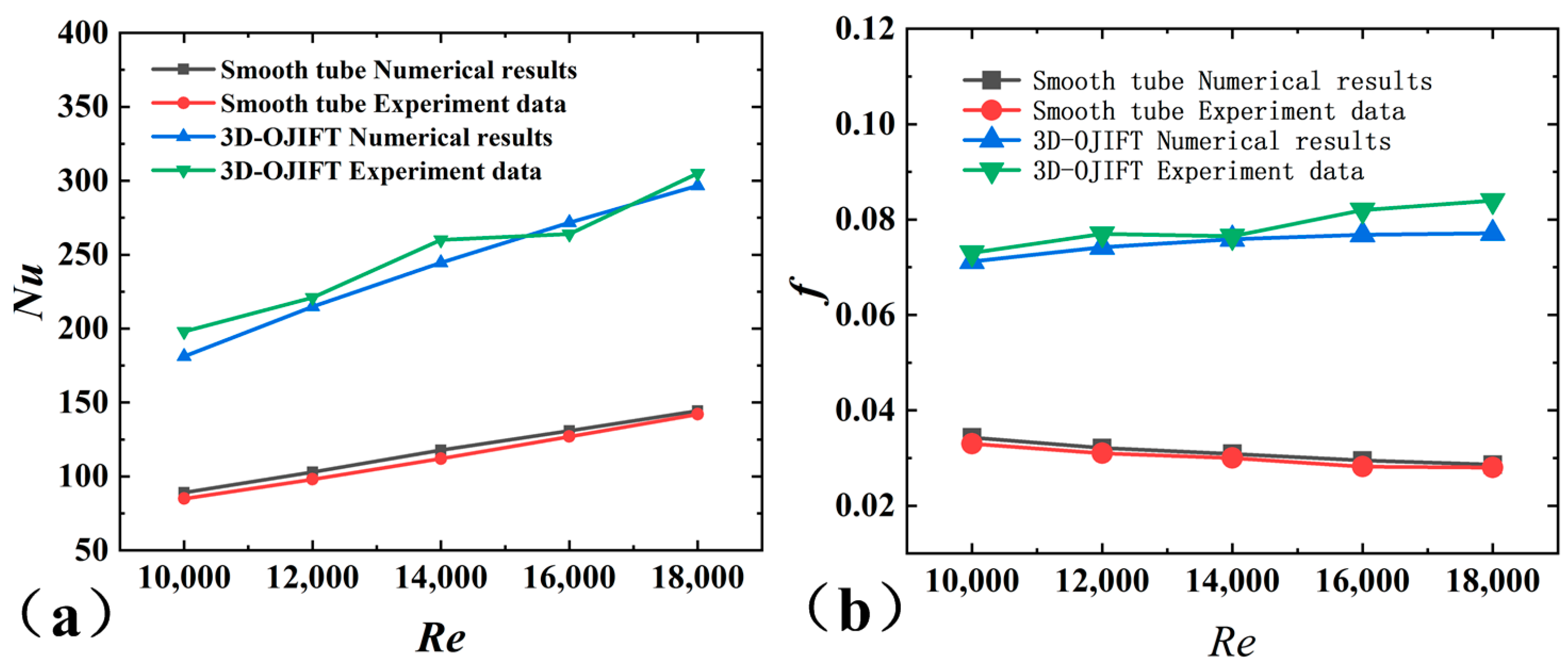


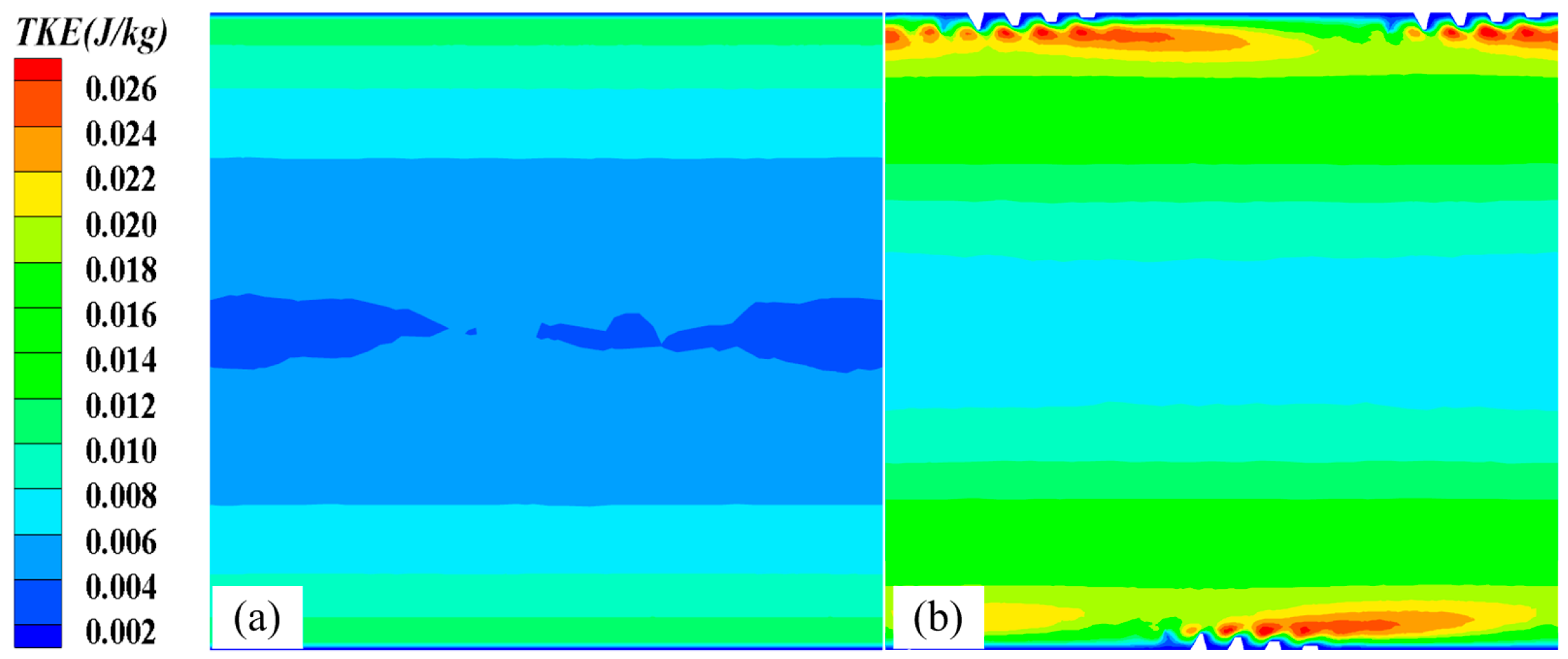
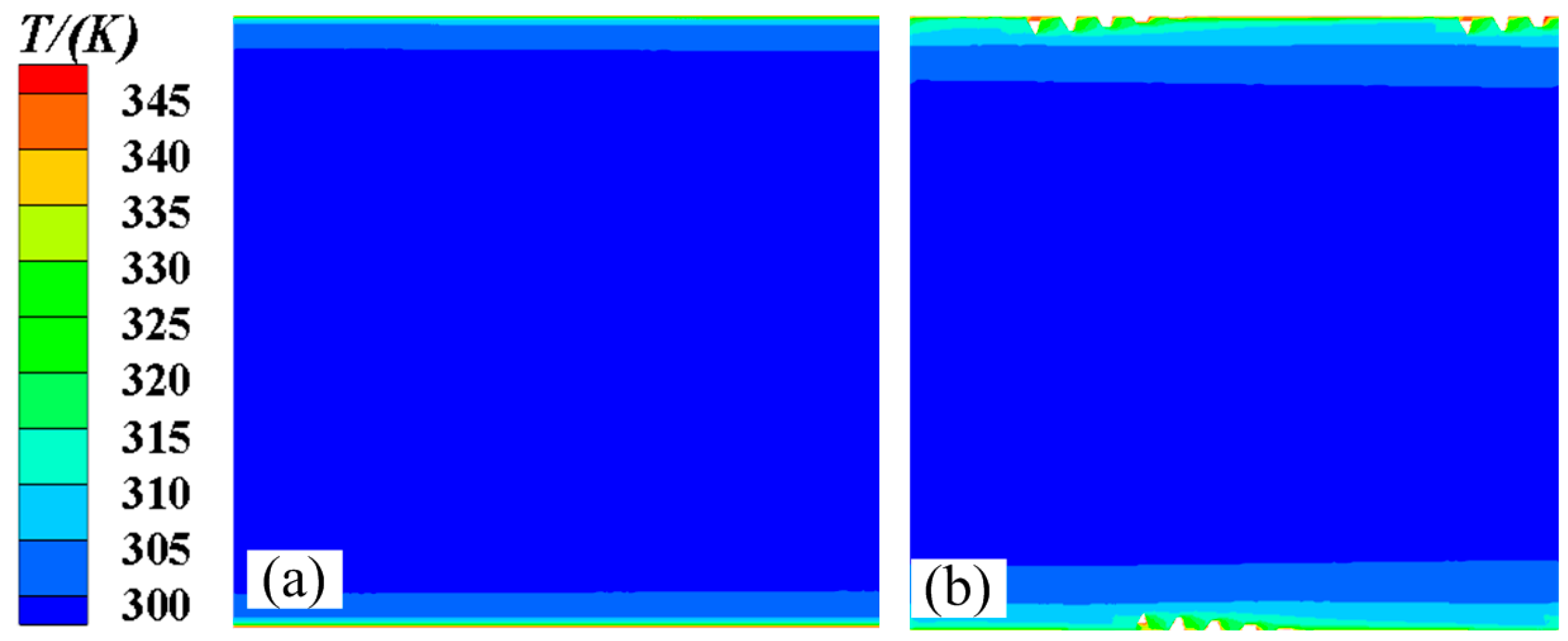
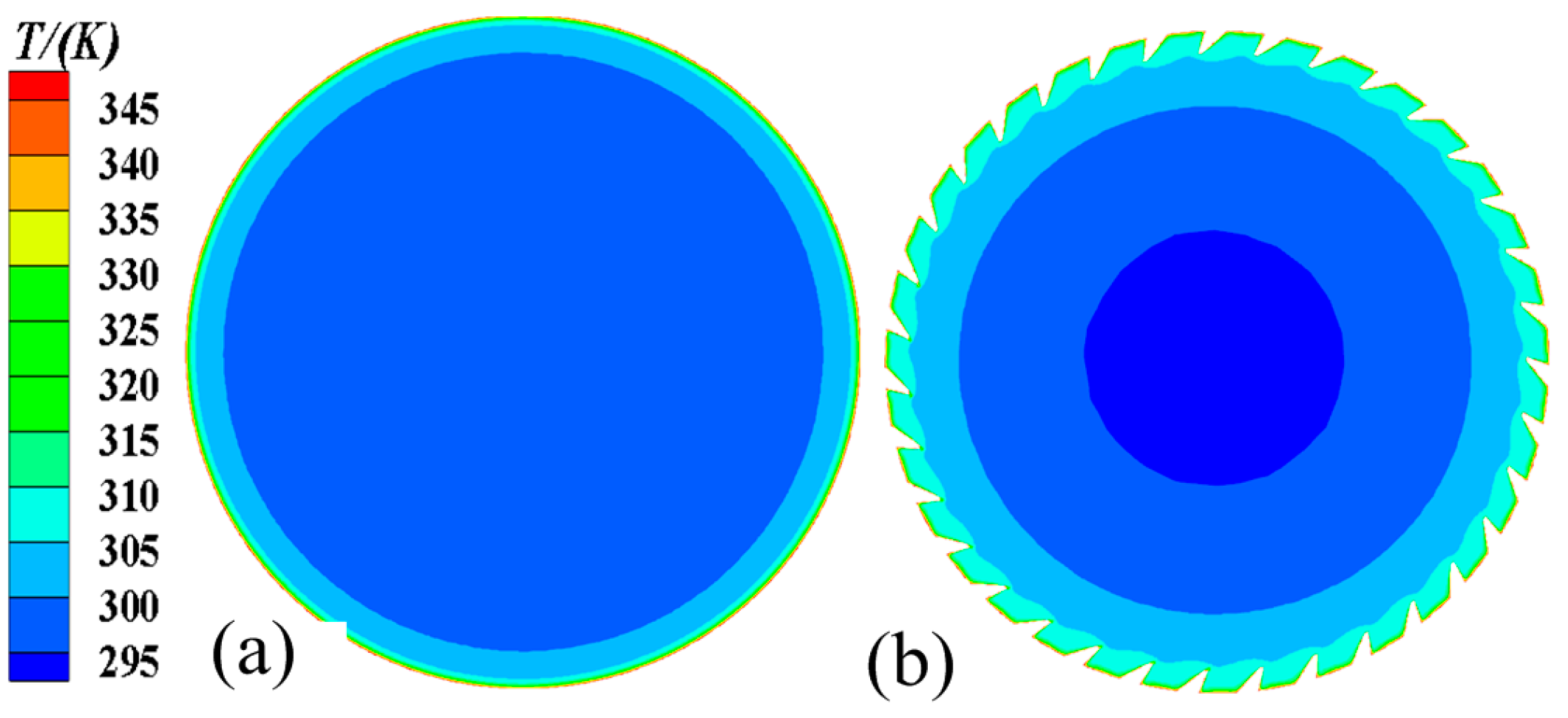

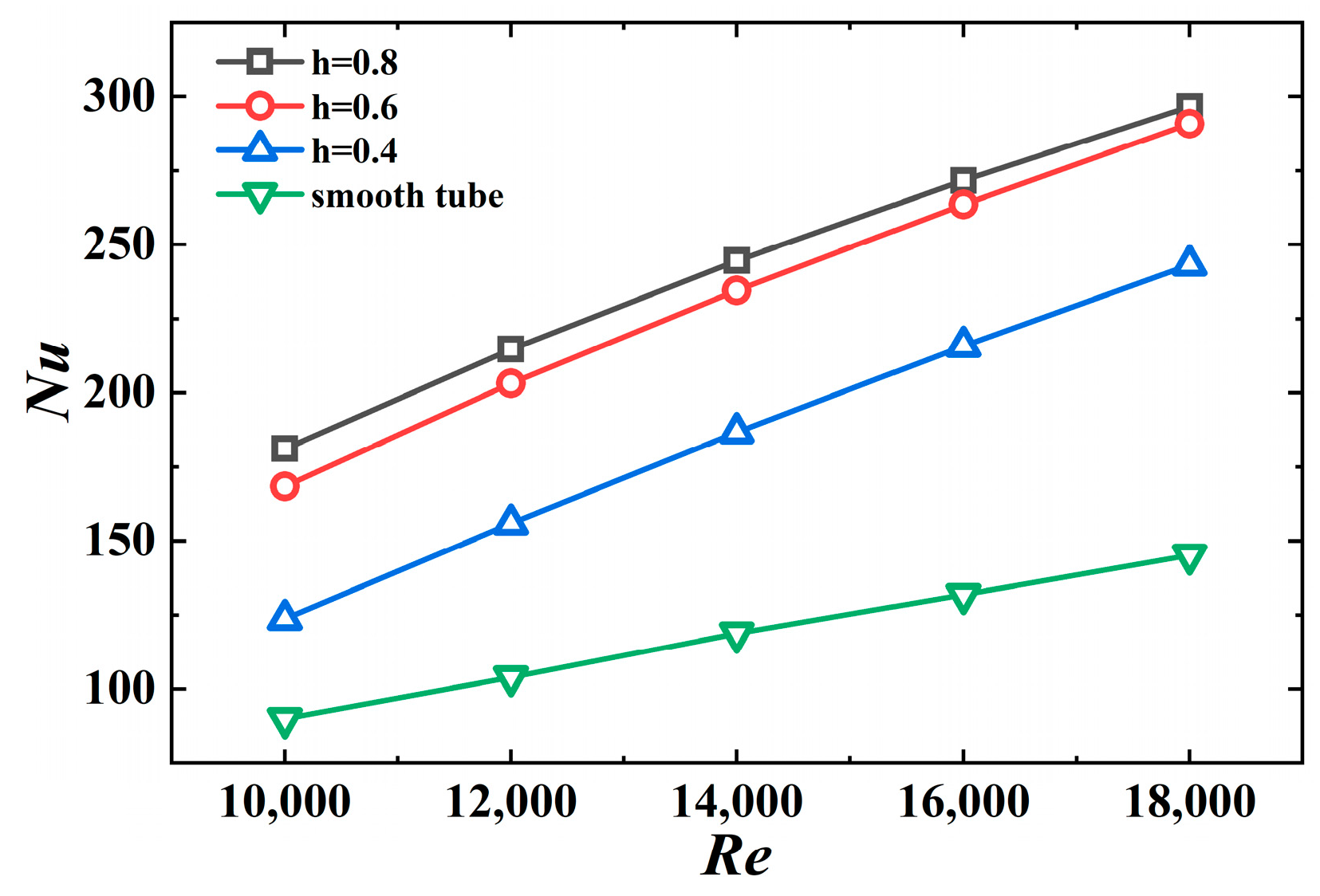


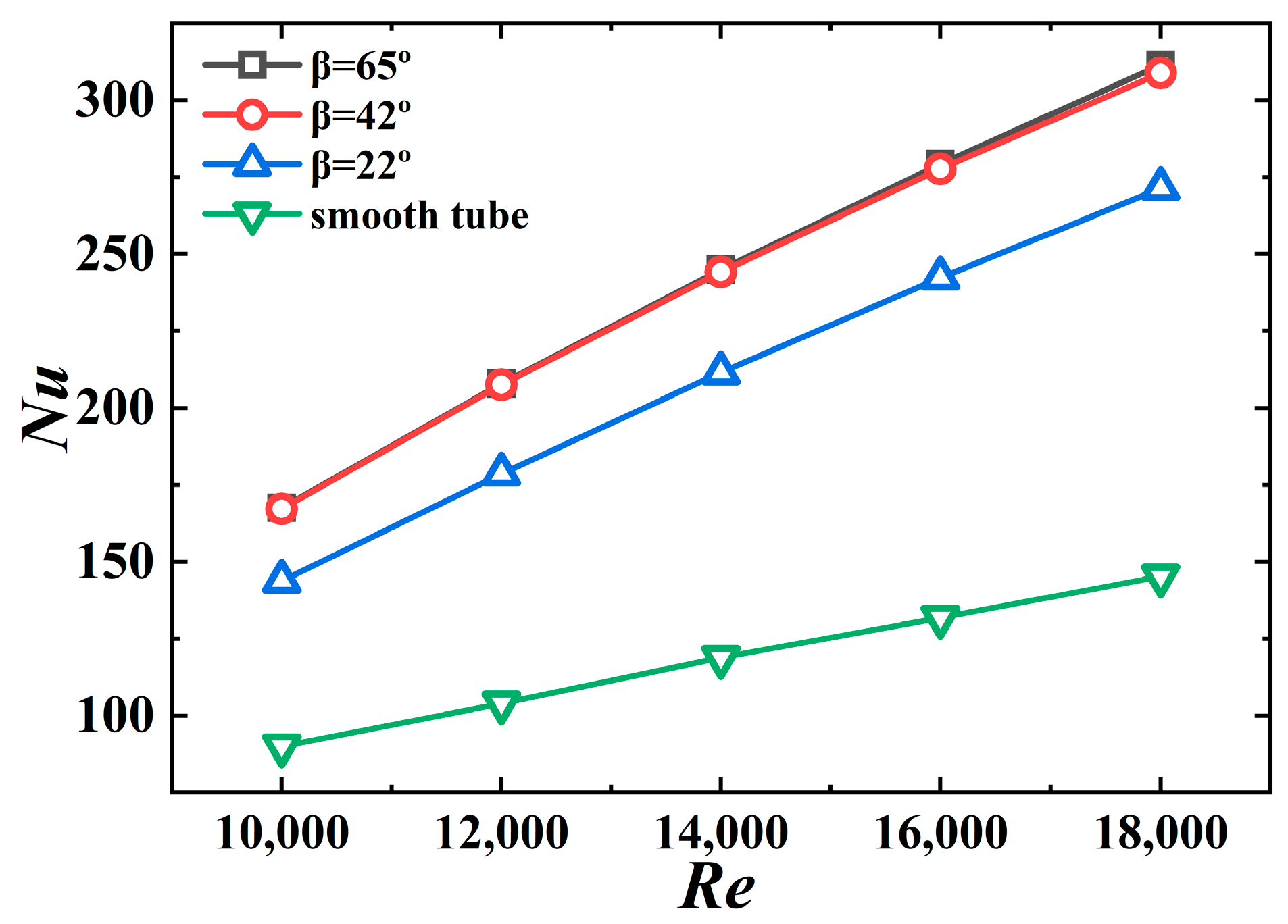
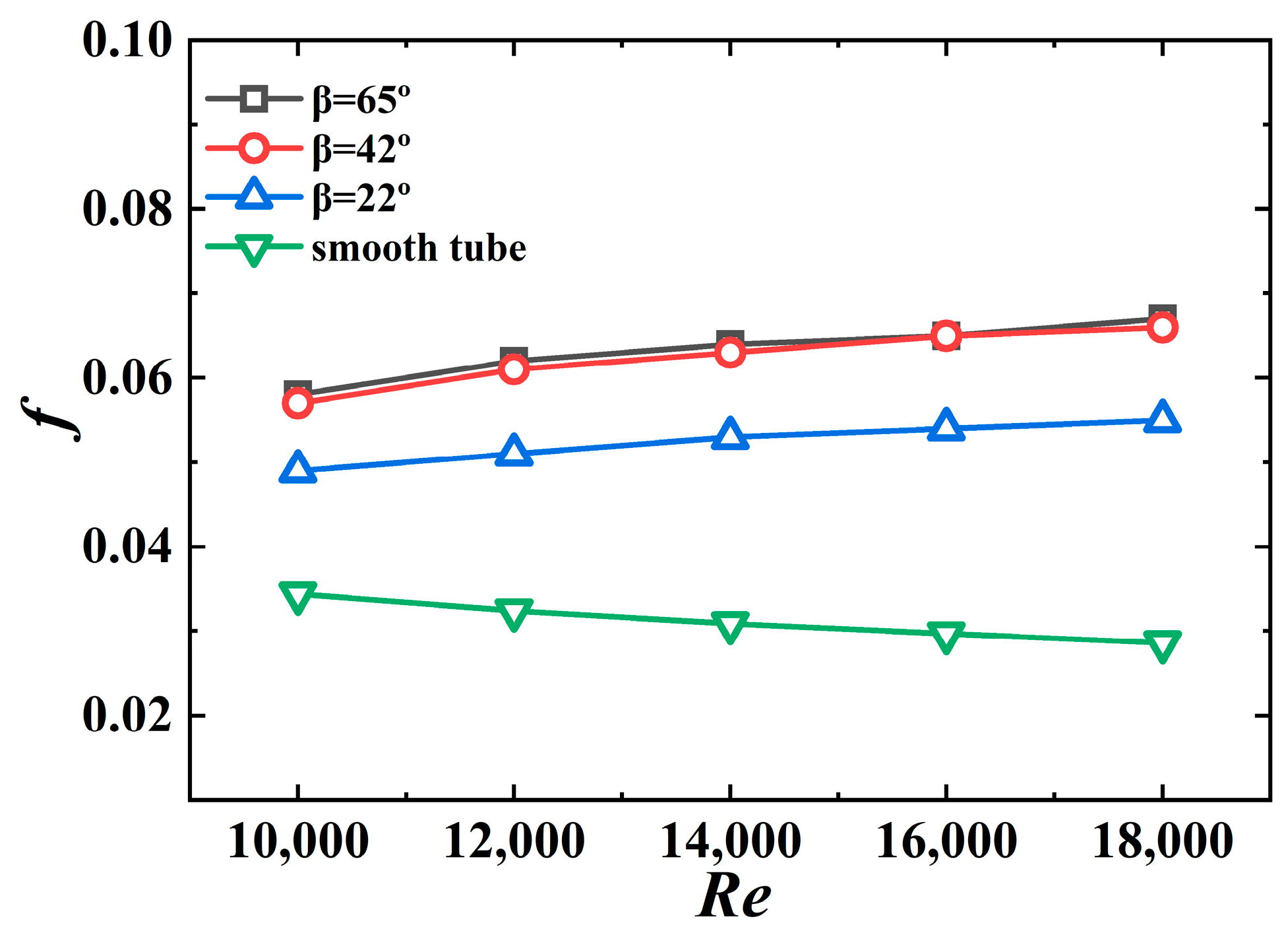
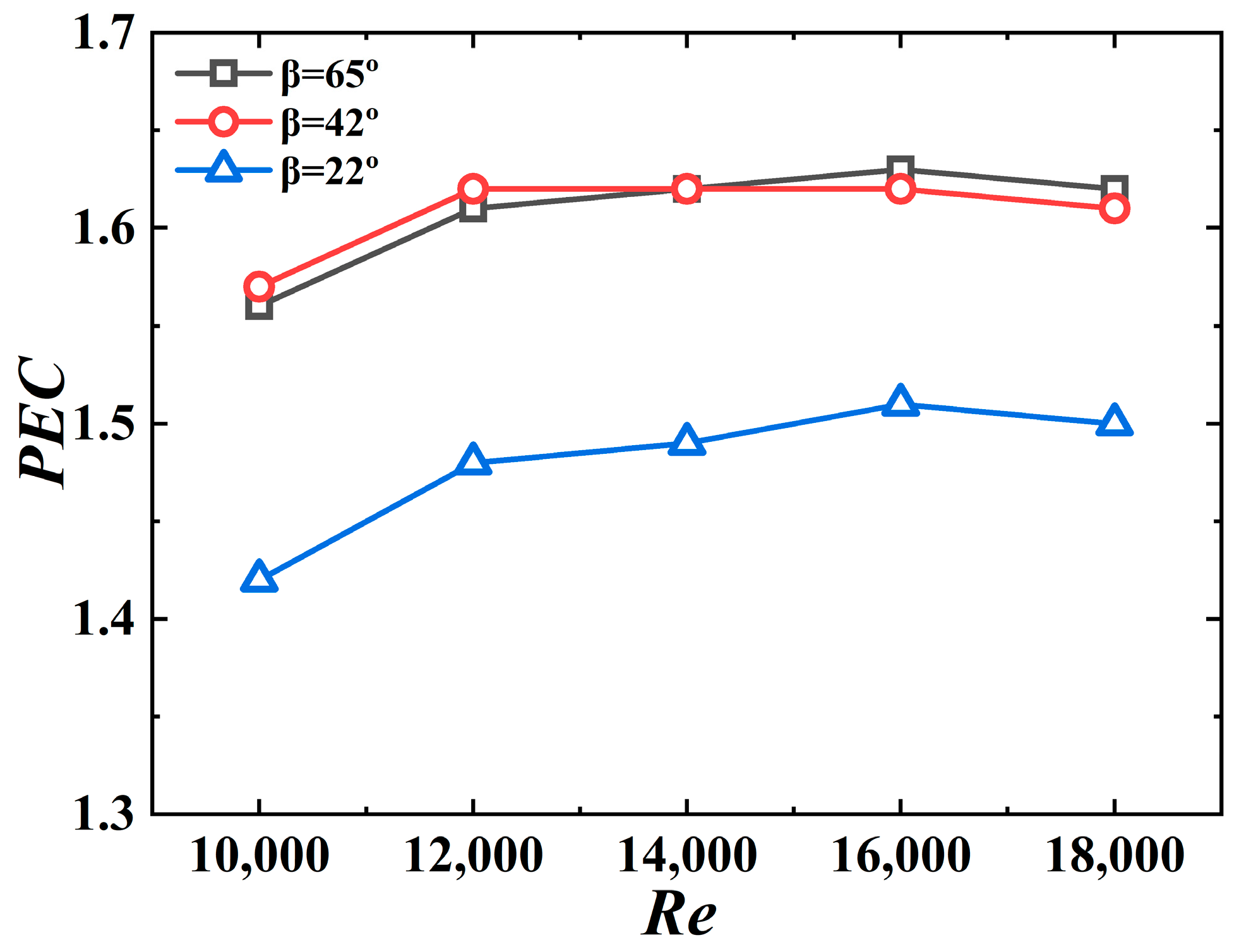
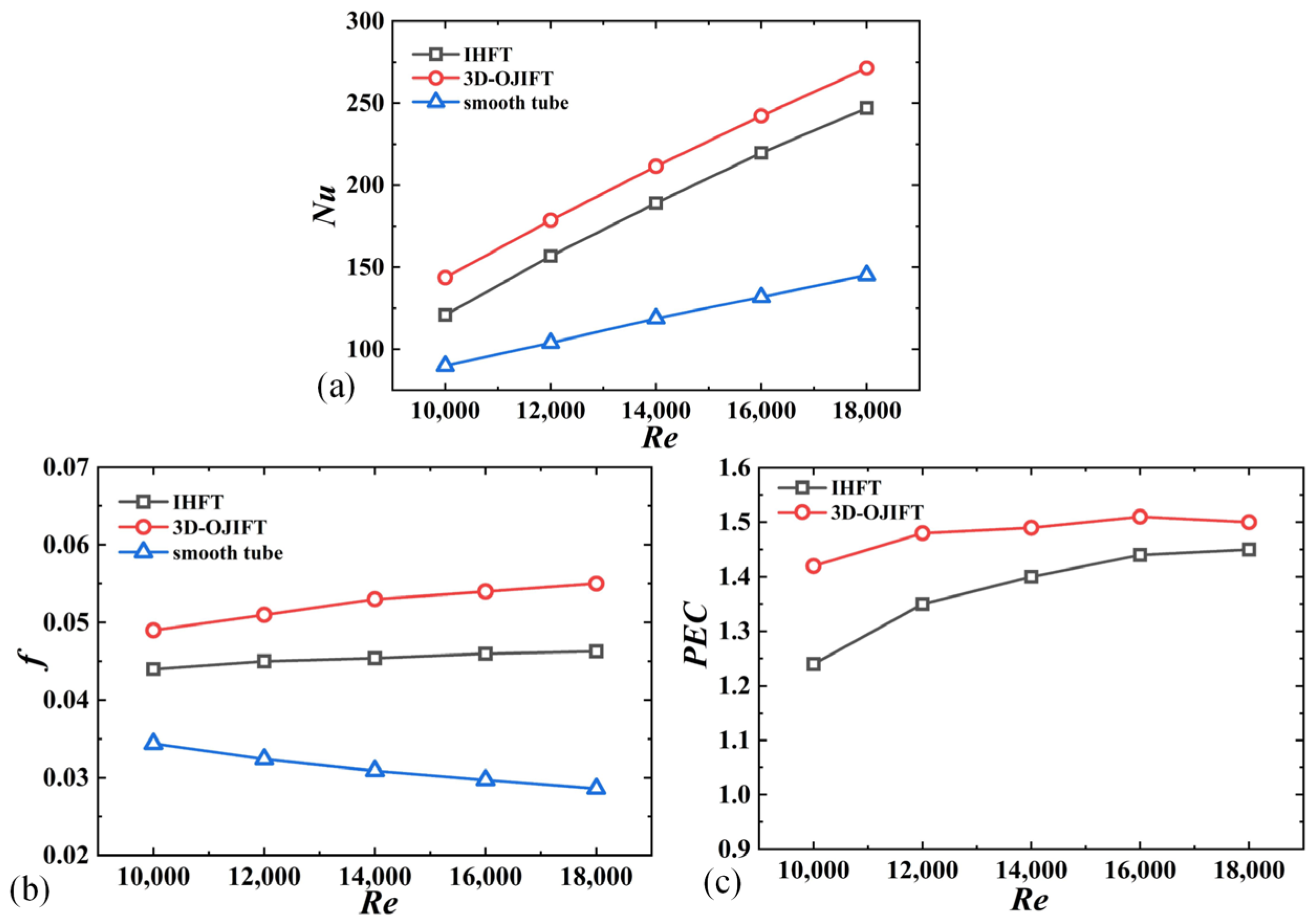
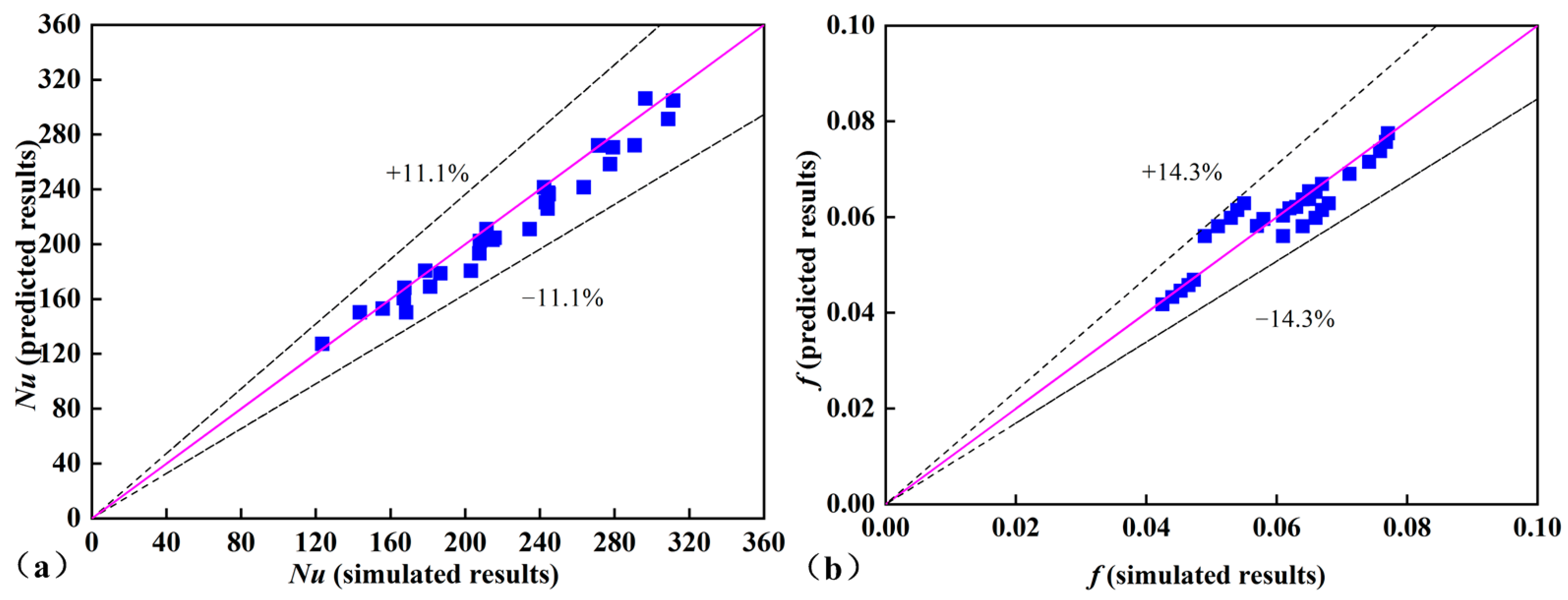
| Authors | Enhanced Structures | Nu/Nup | f/fp | PEC | Re |
|---|---|---|---|---|---|
| Present study | 3D-OJIFT | 2.01–2.04 | 2.01–2.69 | 1.46–1.58 | 10,000–18,000 |
| Li et al. [31] | Internal helically finned tube | 1–2.0 | 1–3.0 | 1–1.38 | 2500–15,000 |
| Dizaji et al. [32] | Corrugated tube | 1.5–1.75 | 3.52–3.48 | 0.98–1.19 | 7000–17,500 |
| Vicente et al. [33] | Dimpled tube | 1.5–2.1 | 3.2–4.2 | 1.01–1.36 | 2000–19,000 |
Disclaimer/Publisher’s Note: The statements, opinions and data contained in all publications are solely those of the individual author(s) and contributor(s) and not of MDPI and/or the editor(s). MDPI and/or the editor(s) disclaim responsibility for any injury to people or property resulting from any ideas, methods, instructions or products referred to in the content. |
© 2024 by the authors. Licensee MDPI, Basel, Switzerland. This article is an open access article distributed under the terms and conditions of the Creative Commons Attribution (CC BY) license (https://creativecommons.org/licenses/by/4.0/).
Share and Cite
Huang, S.; Deng, M.; Chen, Z.; Yang, D.; Xu, Y.; Lan, N. Experimental and Numerical Investigations on Thermal-Hydraulic Performance of Three-Dimensional Overall Jagged Internal Finned Tubes. Micromachines 2024, 15, 513. https://doi.org/10.3390/mi15040513
Huang S, Deng M, Chen Z, Yang D, Xu Y, Lan N. Experimental and Numerical Investigations on Thermal-Hydraulic Performance of Three-Dimensional Overall Jagged Internal Finned Tubes. Micromachines. 2024; 15(4):513. https://doi.org/10.3390/mi15040513
Chicago/Turabian StyleHuang, Shufeng, Mingjiang Deng, Zhixin Chen, Dayong Yang, Yingshuai Xu, and Ning Lan. 2024. "Experimental and Numerical Investigations on Thermal-Hydraulic Performance of Three-Dimensional Overall Jagged Internal Finned Tubes" Micromachines 15, no. 4: 513. https://doi.org/10.3390/mi15040513
APA StyleHuang, S., Deng, M., Chen, Z., Yang, D., Xu, Y., & Lan, N. (2024). Experimental and Numerical Investigations on Thermal-Hydraulic Performance of Three-Dimensional Overall Jagged Internal Finned Tubes. Micromachines, 15(4), 513. https://doi.org/10.3390/mi15040513






